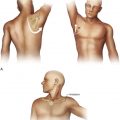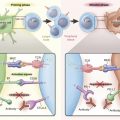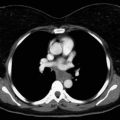Summary of Key Points
- •
The use of mouse models to study the initiation and evolution of lung cancers has been crucial in advancing the field through the identification of putative stem cell niches within the lung.
- •
Bronchoalveolar stem cells (BASCs) are the putative cell of origin for lung adenocarcinoma.
- •
The tumor suppressor gene phosphatase and tensin homolog (PTEN) exerts a brake on BASC transformation to adenocarcinoma.
- •
Basal cells of the trachea are the putative cell of origin for squamous lung cancer.
- •
In small cell lung cancer (SCLC), a common neuroendocrine cell of origin may undergo RAS-driven transformation to a CD44-expressing non-neuroendocrine clone.
- •
Hedgehog (Hh) signaling persists in SCLC and is required for tumor growth in mouse xenograft models.
The cancer stem cell hypothesis, when applied to lung cancers, is underpinned by the concept of a cellular hierarchy in which a relatively rare somatic stem cell population with self-renewal capability, differentiation, and innate drug resistance gives rise to the bulk of the cancer. Evidence of this concept has been reported in studies on hematologic malignancies and solid cancers. Lung cancers, like other cancers, are heterogeneous with respect to histology and are spatially associated with the cellular origin of initiation. With the advent of large-scale DNA sequencing, heterogeneity at the genetic level has been observed within these histologic subclasses, especially in adenocarcinomas. This heterogeneity in adenocarcinomas indicates complexity in the mechanisms underlying cellular initiation and evolution of lung cancers as a result of specific mutational processes. This chapter focuses on the evidence supporting the existence of spatially restricted initiator cell populations in lung cancer (cells of origin), including evidence for specific pathways involved in their maintenance, as well as the less well-supported evidence for cancer stem cells.
Normal Lung
Over time, a model has been developed in which the lung is subdivided into regions associated with their own stem cell population capable of rapidly responding to lung injury, thus enabling cellular repopulation. Accordingly, the trachea, bronchus, bronchioles, and alveolus exhibit their own complement of cells capable of repopulation following lung injury.
For the trachea and bronchus, these repopulating cells are the basal mucous secretory cells. Evidence supports the existence of a cellular compartment in the human airway surface epithelium that can restore the full repertoire of epithelial lining cells in a xenograft model in severe combined immunodeficiency mice. By contrast, the basal/parabasal origin of tracheal stem cells has been proposed based on data showing that a cytokeratin 5 (CK5), CK14-, and mindbomb E3 ubiquitin protein ligase 1-positive cell population comprising only 0.87% of lung cells accounts for 48% of proliferating cells with basal localization. Tracheal gland ductal cells that express CK14 and CK18 have been shown to retain sulfur dioxide labeling up to 4 weeks after inhalation damage in adult mice and can repopulate the tracheal surface after injury.
In the bronchioles and alveoli, the club cell (formally known as the Clara cell) and type II pneumocyte have been implicated in repopulation. Accordingly, specific depletion of club cells in rodent models by either intraperitoneal naphthalene or activation of the suicide substrate ganciclovir by Clara cell secretory protein (CCSP)-promoter-driven herpes simplex virus thymidine kinase in transgenic mice is sufficient to cause irreversible, fatal lung injury. In rodent fetal lung, the existence of a possible bipolar stem cell (M3E3/C3) capable of differentiating into club or type II pneumocytes when grown in different media is supported by data from Finkelstein et al. Bleomycin causes specific alveolar type I (AT1) cell injury, and it has been proposed that AT2 cells can repopulate and repair the alveolar epithelium. A unique, naphthalene-resistant stem cell population has been identified at the bronchoalveolar junction and can repopulate the terminal bronchioles after club cell depletion injury. These cells express CCSP and are independent of the neuroepithelial body microenvironment, implicating a distinct stem cell niche. Similarly, a so-called side population of cells (i.e., a rare cellular subset enriched for stem cell activity) exhibiting typical breast cancer-resistant protein-mediated Hoechst dye efflux has been identified in 0.03% to 0.07% of total lung cells.
Nonsmall Cell Lung Cancer
Adenocarcinoma and the Cells of Origin
Nonsmall cell lung cancer (NSCLC) can be subdivided into two distinct subtypes that reflect the histologic characteristics of distinct regions within the lung: 80% are adenocarcinomas and 20% are squamous cell carcinomas. The adenocarcinoma subtype and adenoma precursors exhibit club and AT2 cell markers consistent with a peripheral or endobronchial origin, whereas squamous cell carcinomas exhibit mature epithelial cell characteristics consistent with trachea and proximal airways origin. The AT2-specific marker surfactant protein has been shown to be expressed in lung adenocarcinoma and squamous cell carcinomas. Accordingly, Ten Have-Opbroek et al. postulated that the AT2 cell may be the pluripotential cell for NSCLC in humans.
Isolation of a CD133-Positive Stem-Like Population in Lung Cancer
Rare populations of cells (<1.5%) have been shown to form colonies in soft agar and recapitulate features of the original lung cancer in athymic mice. In a study that was aimed to isolate rare populations of cells from primary lung cancer specimens expressing the marker CD133, an undifferentiated cell population was identified, capable of indefinitely growing as tumor spheres in serum-free medium containing epidermal growth factor and basic fibroblast growth factor. This approach had previously been used to isolate a putative hemopoietic cell of origin in human acute myeloid leukemia. These putative lung cancer stem cells were able to acquire specific lineage markers in tumor xenografts (which were identical to the original tumor) and differentiated to lose tumorigenic potential and CD133 expression. In association with aldehyde dehydrogenase 1A1, a marker of the stem cell phenotype, CD133 has been shown to be associated with a poor prognosis—related to shorter recurrence-free survival—for patients with lung cancer.
In previous studies, CD133-positive cells have been isolated from cell lines. In one study, CD133-positive cells were found to coexpress octamer-binding transcription factor 4 (OCT-4), NANOG, alpha-integrin, and C-X-C chemokine receptor type 4, and these cells were found to be resistant to cisplatin. In another study, following chemotherapy, cells with CD133 were isolated and then enriched in the surviving populations with CD133 positivity. Consistent with the observation that isolated CD133-positive cells are resistant to cisplatin, selecting cells specifically for resistance to cisplatin over several months through long-term treatment led to enrichment of a CD133-positive/CD44-positive/aldehyde dehydrogenase-active clone that expresses NANOG/OCT-4/sex determining region Y- box 2 (SOX2). However, isolation of CD133-positive cells from the A549 cell lines has also been shown to result in high potential for liver metastases, and tumor growth factor-beta has been shown to increase the migratory capacity of these CD133-positive A549 cells in association with induction of epithelial to mesenchymal transition.
The Cell of Origin in Conditional Oncogene-Driven Adenocarcinoma
Activating mutations of Kirsten rat sarcoma (KRAS) are identified in approximately 25% of adenocarcinomas. A Lox-Stop-Lox KRAS conditional mouse strain (LSL K-ras G12D) harboring an oncogenic KRAS under control of a removable transcriptional termination stop element by adeno-CRE infection has been reported as a model for monitoring the initiation of tumor formation over time through different stages of progression. Three distinct types of lesions have been identified: atypical adenomatous hyperplasia (AAH), epithelial hyperplasia of the bronchioles, and adenomas. AAH is an atypical epithelial cell proliferation that grows along the alveolar septa but is noninvasive; it has been proposed by Kerr to be an adenoma-like precursor of adenocarcinoma. Immunohistochemical analysis has shown negativity for the Clara cell-specific marker Clara cell antigen (CCA) and positivity for AT2 cell-specific marker prosurfactant apoprotein-C (pulmonary surfactant apoprotein C [SP-C]) consistent with AT2 cell origin. By contrast, epithelial hyperplasia lesions exhibit CCA positivity and SP-C negativity consistent with club cell origin. Importantly, endothelial hyperplasia lesions contiguous with AAH lesions exhibit double CCA/SP-C expression at the single-cell level, demonstrating a unique double-positive population that exhibits properties of both club and AT2 cells. Monitoring progression following KRAS activation over time has demonstrated formation of adenomas (outnumbering AAH lesions) at 12 weeks after adeno-CRE infection, and adenocarcinomas that form at 16 weeks in the absence of AAH lesions suggest a precursor origin of these cancers.
SP-C/CCA double-positive cells have been subsequently shown to be the putative cell of adenocarcinoma origin in the LSL-K-ras G12D model. Such double-positive cells, which express markers of both AT2 and club cells, have been previously identified in mice. In normal adult lungs, double immunofluorescence has been used to identify a subpopulation of cells that are positive for CCA and SP-C and that are restricted through localization to the bronchoalveolar duct junction; CCA is distributed in the columnar bronchial epithelium and SP-C in the AT2 cells. These double-positive cells respond to both naphthalene- and bleomycin-induced lung injury by proliferating, while club cell or AT1 cell loss occurs as a result of specific toxicities.
Isolation of these double-positive cells has shown a putative stem cell population—termed BASCs—that reside at the bronchoalveolar duct junction and repopulate the bronchiolar or alveolar epithelium following damage. BASCs constitute 0.4% of the total lung cell population and exhibit an immunophenotype that is negative for platelet endothelial cell adhesion molecule (Pecam), CD45, and CD34 and positive for stem cell antigen 1 (Sca1). These cells are clonal, as evidenced by single-cell culture. BASCs exhibit multipotent lineage potential and can give rise to AT2-like or club-like cells while undergoing self-renewal during culture.
During tumorigenesis in the LSL-K-ras G12D model, infection with adeno-CRE leads to an expansion of the BASC pool, coincident with the formation of AAH. The amount of BASC expansion correlates with the titer of adeno-CRE used to infect the LSL-K-ras G12D transgenic mice.
Loss of PTEN Expands the BASC Pool
BASCs require PTEN to prevent formation of lung adenocarcinomas. PTEN is a tumor suppressor that inhibits the phosphoinositide 3 kinase (PI3K)/AKT survival pathway by dephosphorylating phosphatidylinositol-3,4,5-trisphosphate at the cell membrane, and it is required for maintenance of other organ-specific stem cells. Loss of PTEN is a frequent occurrence in lung adenocarcinoma. To study the effects of PTEN, bronchoalveolar epithelium-specific, PTEN-deficient mice were established. These mice had impaired lung morphogenesis, impaired alveolar epithelial cell differentiation, defective expression of the molecular markers (increased sprouty gene 2 [ Spry2 ] and sonic hedgehog [Shh]), and bronchoalveolar epithelial hyperplasia. Furthermore, loss of PTEN led to an increase in the numbers of BASCs and was sufficient to induce spontaneous adenocarcinomas, of which 33% were shown to exhibit secondary codon 61 KRAS mutations. By contrast, PI3K has been shown to mediate BASC expansion in oncogenic KRAS-induced lung cancer, demonstrating a critical role for this pathway in regulating the stem cell pool during formation of adenocarcinomas. As with the PI3K pathway, Gata6-wingless-related integration site (wnt) signaling and B lymphoma Moloney murine leukemia virus insertion region 1 homolog (Bmi1) have been identified as regulators of BASC expansion.
Maintenance of Stem Cell Populations: Notch and Wnt Signaling
Asymmetric cell division is a characteristic of stem cells that is regulated by the highly conserved notch signaling pathway, which, in turn, is mediated by cell–cell interactions. This pathway is involved in normal lung development, as evidenced by knockout of the downstream notch target hairy and enhancer of split 1 (Hes1), which is expressed in neuroendocrine cells and is associated with their expansion. In RAS-transformed cells, RAS increases the level and activity of the notch pathway by increasing the levels of intracellular notch-1, and upregulating notch ligand delta-1 and p38 pathway-dependent processing of presenilin-1. This notch activation is essential for maintaining the neoplastic phenotype in vitro and in vivo. Recently, it has been shown that Notch3 signaling in KRAS-driven adenocarcinoma is dependent on the oncogene protein kinase C iota (PKCiota), and simultaneous pharmacologic inhibition of both Notch and PKCiota exhibits synergistic antagonism of KRAS-driven lung adenocarcinoma in vitro and in vivo. The Wnt pathway activation is essential for maintaining the cancer stem cell phenotype and, although not commonly mutated in NSCLC, is constitutively activated. It has recently been shown that Wnt signaling is enhanced by microRNA 582-3p-mediated suppression of Wnt inhibitors axis inhibition protein 2, Dickkopf WNT signaling pathway inhibitor 3, and secreted frizzled-related protein 1. Inhibition of MiR582-3p results in suppression of Wnt and inhibition of both tumor initiation and in vivo xenograft progression, suggesting its potential as a therapeutic target.
Squamous Cell Lung Carcinoma
Basal cells of the trachea have been implicated as possible cells of origin of squamous cell lung carcinoma. In mouse models, squamous cell lung carcinomas exhibit similar expression patterns of p63, CK5, and CK14, as well as spatial localization to intracartilaginous boundaries and mucosal junctions. CK5-positive basal cells have self-renewal properties and are under the control of SOX2; in squamous cell lung carcinomas, the SOX2 gene is frequently amplified at chromosome 3q26.33.
Small Cell Lung Cancer
Neuroendocrine Airway Epithelia and the Origin of Small Cell Lung Cancers
SCLC arises from cells residing in the epithelial lining of the bronchi and exhibits a neuroendocrine phenotype. Approximately 90% of SCLCs exhibit inactivating mutations in both p53 and retinoblastoma 1 (Rb1) tumor suppressor genes. Accordingly, a transgenic mouse model has been established with use of Cre-Lox-mediated, epithelial-specific deletion of both Rb1 and p53. Coincidental loss of these tumor suppressor genes leads to the formation of neoplastic lesions following intratracheal intubation. These lesions exhibit neuroendocrine differentiation, as evidenced by expression of synaptophysin (Syp) and neural cell adhesion molecule (Ncam1, also known as CD56), consistent with germline mutation of these genes in mice. No proliferation of club or AT2 cells has been reported, despite these cells harboring p53/Rb1 mutations in the transgenic model, which suggests a specific genotype–phenotype interaction in the neuroendocrine cell pool. Similar to humans, transgenic mice harboring SCLC can express anti-Hu antibodies (14% compared with 16% of humans).
Restricting the targeting Rb1/p53 loss to specific lung epithelial cell subsets has demonstrated that targeting of either neuroendocrine or AT2 cells can lead to the formation of SCLC (the latter with lower efficiency). By contrast, however, club cells are resistant to this path of transformation. This technique has enabled identification of the cell type of origin in pancreatic and prostate cancers. The finding that club cells are resistant to neuroendocrine cells with respect to transformation by conditional p53/Rb1 loss implies that neuroendocrine cells are the predominant cell of origin associated with SCLC, although AT2 cells also have the capacity to transform.
Neuroendocrine Hedgehog Signaling Mediates Airway Repair and SCLC
A naphthalene-induced acute lung injury model leads to loss of club cells approximately 24 hours after administration, with epithelial regeneration occurring within 72 hours, as well as an expansion of rare neuroendocrine cells. During this regeneration phase, there is activation of widespread Hh pathway signaling, evidenced by upregulation of Hh signaling (Shh ligand and GLI protein). However, GLI is lost following neuroendocrine differentiation by day 4 after naphthalene-induced injury in nascent calcitonin gene-related peptide-positive epithelial cells. Using a transgenic model to monitor Hh signaling by replacing one allele of Ptch (a transcriptional target of GLI proteins) with beta-galactosidase, it has been possible to show that during normal development, this pathway is activated in the airway epithelial compartment.
Hh signaling persists in SCLC, as evidenced by GLI and Shh expression in 50% of primary SCLC specimens (in contrast to 23% in NSCLC). SCLC cells and xenografts are dependent on Hh signaling for growth, as evidenced by sensitivity to cyclopamine and, conversely, their rescue by ectopic expression of GLI1, similar to medulloblastoma. SCLC cells do not exhibit mutations in Ptch, but rather exhibit juxtacrine Hh signaling similar to that seen in development and airway repair.
Tumor Heterogeneity and SCLC
One of the unique clinical features of SCLC is initial sensitivity to chemotherapy, followed by recurrence and a marked acquisition of resistance, occasionally associated with a transformation to the NSCLC phenotype. This behavior of SCLC probably reflects underlying tumor heterogeneity, with initial selection for a culture of clones that are resistant to chemotherapy. SCLC cell cultures derived from primary SCLC specimens grow as suspensions of small cellular aggregates, with some that attach to plastic dishes. This activity has also been noted for cells derived from disaggregation of tumors from Rb1/p53 transgenic mice harboring SCLCs. In the latter model, attaching cells exhibit a large cell phenotype without expressing the neuroendocrine markers achaete-scute homolog 1 (Ash1) or Syp, in contrast to paired suspension cells from each tumor. Gene expression profiling data obtained from these paired cell lines have been analyzed by principal component analysis and demonstrated two groups: small cell clones (neuroendocrine) and large cell clones (non-neuroendocrine). Only the neuroendocrine cell type is capable of generating SCLC tumors when injected into BALB/c NU/NU nude mice, whereas the large cell tumors generated by subcutaneous injection exhibit a mesenchymal phenotype expressing CD44. Neither cell type can regenerate the heterogeneity seen in the primary tumor; however, they exhibit a clonal relationship evidenced by spectral karyotyping and comparative genomic hybridization.
H-Ras signaling has been shown to drive transition of SCLC to a dedifferentiated phenotype characterized by downregulation of neuroendocrine markers. When neuroendocrine cells from SCLC cell lines obtained from Rb1/p53 transgenic mice are retrovirally transduced with RAS V12 , they undergo a transition to an adherent phenotype with downregulation of neuroendocrine markers Syp and Ash1 and expression of CD44, and a shift in gene expression, with clustering of non-neuroendocrine cells on principal component analysis. Mixing neuroendocrine and non-neuroendocrine clones leads to cell–cell crosstalk that confers metastatic potential. Together, these data suggest that a common neuroendocrine cell of origin may undergo RAS-driven transformation to a CD44-expressing non-neuroendocrine clone.
Stay updated, free articles. Join our Telegram channel

Full access? Get Clinical Tree







